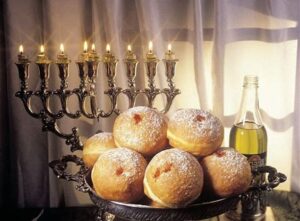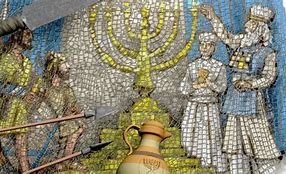Go directly to the musical CHANUKAH CARDS at FREDGRAMS.COM.
The importance of the Jewish holiday Chanukah revolves around the story of the Macabees, the 5 sons of Mattathias who liberated the Second Temple of Jerusalem and the Jewish people in a three year war (167-164 B.C.E) against Syrian King Antiochus IV Epiphanes. There is no mention of this in the Old Testament(Torah) having occurred long after the Jewish Bible was set down, and various aspects of the story as it’s come down to us took shape in written accounts over at least 6 centuries after the event.
It was 250 years after that historian Flavius Josephus (37 A.D-100 A.D) commemorates the victory of Judah Macabee and his 4 brothers as the Festival of Lights.
A century later, in the Mishnah section of the Talmud, (the ancient interpretative guide to the law as laid down in the Torah), it would be called Chanukah [“dedication”] in reference to the re-dedication of the Temple after years of defilement by Antiochus. This took place at the direction of the Macabees on the 25th day of the month Kislev on the Jewish calendar (November/December) as a late celebration of Sukkot, the Festival of the Harvest. It is in the Gemara section of the Babylonian Talmud that details of Chanukah’s formal observance are more specifically described.

As Dostoyevsky’s cynical Grand Inquisitor understood, religious faith acquires its mystical power over people through miracle, mystery and authority. So it is suspected that early rabbinic scholars expanded upon the stirring Macabee story of freedom with the supernatural Miracle of the Oil that burned without replenishment for 8 days in the Temple. Thus, the lighting of candles over 8 days of Chanukah, a miraculous Festival of Lights, renewal and liberation.
 The frying of foods in oil such as latkes (potato pancakes) and suganiyot (jelly donuts) is a celebratory reference to the Miracle.
The frying of foods in oil such as latkes (potato pancakes) and suganiyot (jelly donuts) is a celebratory reference to the Miracle.
Chanukah’s close proximity to Christmas on the civil Western calendar now provides a doubly joyful celebration of our modern Western society’s Judeo-Christian roots at year’s end.
The key events of Judaism in the last century gives further significance to Chanukah. The rise of Zionism, the yearning for a permanent Jewish State homeland; the Holocaust; Israel’s miraculous founding and flowering; its ongoing fight for life waged to this day on the very soil on which the Macabees fought only underscore the relevance of Chanukah’s central themes of oppression, survival, human liberty triumphant. There is no story that better embodies the reality of the Jewish saga, past, present and future.
Go directly to the musical CHANUKAH CARDS at FREDGRAMS.COM.


[…] Read a history of Chanukah on this Blog. […]